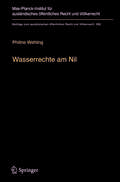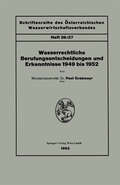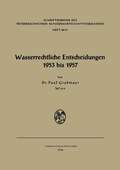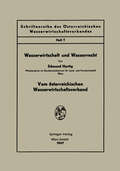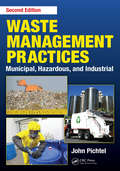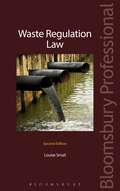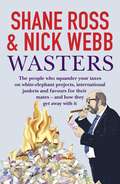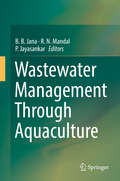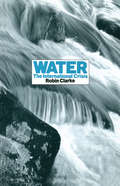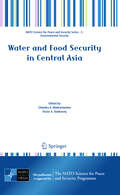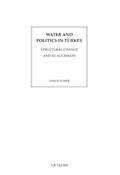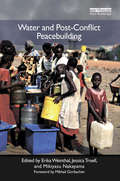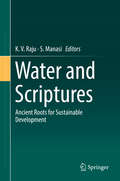- Table View
- List View
Wasserrechte am Nil: Der Einfluss des internationalen Wasserrechts auf die Entwicklung eines Vertragsregimes zur Nutzungsverteilung und gemeinsamen Wasserwirtschaft am Beispiel des Nils (Beiträge zum ausländischen öffentlichen Recht und Völkerrecht #269)
by Philine WehlingDas Buch befasst sich mit den Vorgaben des internationalen Wasserrechts für Abkommen zwischen Anrainerstaaten über die Nutzung und Bewirtschaftung gemeinsamer Wasserläufe. Der aktuelle Stand des internationalen Wassergewohnheitsrechts wird dargelegt und der Regelungsgehalt der UN-Wasserlaufkonvention erläutert, Abkommen auf regionaler und wasserlaufspezifischer Ebene werden skizziert. Anschließend werden die bisherigen Nilverträge und das noch nicht in Kraft getretene Kooperationsrahmenabkommen für den Nil dargestellt, rechtlich gewürdigt und auf ihre Übereinstimmung mit dem internationalen Wasserrecht untersucht. Auch die eingehende Prüfung einer Vertragsnachfolge Südsudans ist Teil der Darstellung. Schließlich wird das völkerrechtliche Leitprinzip zur Nutzungsverteilung, der Grundsatz ausgewogener und angemessener Nutzung, auf den Nil angewandt und dazu konkretisiert. Die Arbeit zeigt auf, inwieweit dieser Grundsatz ein Konzept für eine Nutzungsverteilung in der Praxis zu liefern vermag.
Wasserrechtliche Berufungsentscheidungen und Erkenntnisse 1949 bis 1952 (Schriftenreihe des Österreichischen Wasserwirtschaftsverbandes)
by Paul GrabmayrWasserrechtliche Entscheidungen 1953 bis 1957 (Schriftenreihe des Österreichischen Wasserwirtschaftsverbandes #36/37)
by Paul GrabmayrWasserwirtschaft in der gewerblichen Schifffahrt
by Uwe JacobshagenIn der Schifffahrt spielt Wasser allenthalben eine wichtige Rolle, in der gewerblichen Schifffahrt wird Wasser auch als Brauchwasser, als Grau- und Schwarzwasser sowie zur Nutzung durch den Menschen als Trinkwasser benötigt. Diese Wasserarten, als Grundlage der Wasserwirtschaft auf gewerblich genutzten Schiffen, werden im Buch eingehend definiert. Die Eigentumsarten bzw. Eigentumsverhältnisse, als Voraussetzung für die Nutzung des Wassers, sind beschrieben und die rechtliche Befugnis, das Wasser für die Zwecke an Bord zu verwenden oder ein Gewässer durch einen Gebrauch an Bord zu verändern ist erläutert. Es hilft Schifffahrtstreibenden, Eignern sowie Verantwortlichen im öffentlichen Dienst und Juristen die sich mit der Thematik befassen, die Zusammenhänge sowie den regulatorischen Rahmen zu verstehen bzw. zu vertiefen.
Wasserwirtschaft und Wasserrecht (Schriftenreihe des Österreichischen Wasserwirtschaftsverbandes #7)
by Edmund HartigWaste Management Practices: Municipal, Hazardous, and Industrial, Second Edition
by John PichtelWaste Management Practices: Municipal, Hazardous, and Industrial, Second Edition addresses the three main categories of wastes (hazardous, municipal, and "special" wastes) covered under federal regulation outlined in the Resource Conservation and Recovery Act (RCRA), an established framework for managing the generation, transportation, treat
Waste Management Practices: Municipal, Hazardous, and Industrial, Second Edition
by John PichtelWaste Management Practices: Municipal, Hazardous, and Industrial, Second Edition addresses the three main categories of wastes (hazardous, municipal, and "special" wastes) covered under federal regulation outlined in the Resource Conservation and Recovery Act (RCRA), an established framework for managing the generation, transportation, treat
Waste Regulation Law
by Louise SmailDrawing on the author's practical knowledge of British waste regulation law, this book contains a comprehensive account of relevant legislation plus a detailed interpretation of the statutory provisions and associated case law.The new edition contains updated sections on the Scrap Metal Dealers Act 2013, explaining the differences between the law in England and Wales compared to Scotland and discusses the impact the Water Act 2014 will have on waste regulation law and its enforcement. Helpfully, it features a map of how waste regulation law fits together to aide quick comprehension of which legislation to look at and how each applies to particular industries and types of waste. The book also looks at how international regulation is changing and the impact that this has on UK waste regulation.The detailed treatment of the issues involved will enable practitioners to feel confident in what is a complicated area of law. Previous ISBN: 9781845925765
Waste to Wealth: The Circular Economy Advantage
by Peter Lacy Jakob RutqvistWaste to Wealth proves that 'green' and 'growth' need not be binary alternatives. The book examines five new business models that provide circular growth from deploying sustainable resources to the sharing economy before setting out what business leaders need to do to implement the models successfully.
Wasters
by Nick Webb Shane RossDuring the years when all seemed well with the Irish economy, a scandal bloomed in front of our faces but went mostly unnoticed: the scandal of public waste. Vast overspending on infrastructure (including a number of white elephants), extravagant use of overpriced consultants, the creation of dozens of quangos whose primary purpose seemed to be jobs for the boys, the culture of junketry that took hold in the semi-state sector and the Oireachtas - these and other dubious practices flourished during the years when the state's coffers were overflowing. The insiders benefited; the rest of us got ripped off. Now, as the state scrambles to bail out the banks and to bring order to the shattered public finances by taking money out of the pockets of ordinary working people, Shane Ross and Nick Webb tell the story of the wasters: the people who perfected and benefited from the culture of cronyism and waste. Thanks in large part to Ross and Webb's journalism in the Sunday Independent exposing scandals in FAS and CIE, we already know part of this story. In Wasters, the authors show how wide and how deep the rot runs, and they show that every scandal has one thing in common: insiders profiting at the expense of ordinary people.
Wastewater Management Through Aquaculture
by B. B. Jana R. N. Mandal P. JayasankarThis volume provides state-of-the-art information on soil-water interactions in wastewater systems, characterization of wastewater, modes of treatment, safety of wastewater use, water conservation technologies involved in recycling of sewage in fish culture, biogeochemical cycling bacteria and nutrient dynamics, ecosystem resilient driven wastewater reclamation, bioremediation, aquaponics, ecological integrity, culture practices of fish farming, microbial food web phenomena, fish diseases, environmental economics of wastewater, environmental risk assessment, environmental law and regulations. Given its breadth of coverage, the book will be useful to researchers, teachers, students, administrators, planners, farmers and entrepreneurs interested in the profitable use of wastewater in the wastes-into-wealth framework of for the benefit of humanity, and in achieving the targets for sanitation and safe wastewater reuse by 2030, specified in the United Nations’ Sustainable Development Goals.Concerns are growing about the quality and quantity of fresh water, as severe crises are expected in the near future. Climate change has further worsened the strain on inland water resources, with its major impacts on ecosystems and human life. It is most urgent to protect and conserve inland water resources to maintain vital ecosystem functions. Despite the immense nutrient potentials of wastewater in terms of phosphorus, nitrogen and potassium and increasingly high rates of urbanization-based wastewater generation, wastewater has traditionally been overlooked as a resource. This produces a threefold loss – environmental degradation, monetary losses from fertilizers, and water. As a result, municipal wastewater offers a win-win strategy for water conservation and environmental protection, while also turning waste into wealth in the form of fish biomass and allied cash crops. Wastewater-fed aquaculture refers to a unique, integrated biosystem in which the wastes generated by the first system are used by the next subsystem. In wastewater-fed aquaculture biosystems, the organic wastes are recycled into fish biomass mediated through a complex microbial/autotrophic/heterotrophic food web mechanism.
Wasting a Crisis: Why Securities Regulation Fails
by Paul G. MahoneyThe recent financial crisis led to sweeping reforms that inspired countless references to the financial reforms of the New Deal. Comparable to the reforms of the New Deal in both scope and scale, the 2,300-page Dodd-Frank Act of 2010—the main regulatory reform package introduced in the United States—also shared with New Deal reforms the assumption that the underlying cause of the crisis was misbehavior by securities market participants, exacerbated by lax regulatory oversight. With Wasting a Crisis, Paul G. Mahoney offers persuasive research to show that this now almost universally accepted narrative of market failure—broadly similar across financial crises—is formulated by political actors hoping to deflect blame from prior policy errors. Drawing on a cache of data, from congressional investigations, litigation, regulatory reports, and filings to stock quotes from the 1920s and ’30s, Mahoney moves beyond the received wisdom about the financial reforms of the New Deal, showing that lax regulation was not a substantial cause of the financial problems of the Great Depression. As new regulations were formed around this narrative of market failure, not only were the majority largely ineffective, they were also often counterproductive, consolidating market share in the hands of leading financial firms. An overview of twenty-first-century securities reforms from the same analytic perspective, including Dodd-Frank and the Sarbanes-Oxley Act of 2002, shows a similar pattern and suggests that they too may offer little benefit to investors and some measurable harm.
Wasting a Crisis: Why Securities Regulation Fails
by Paul G. MahoneyThe recent financial crisis led to sweeping reforms that inspired countless references to the financial reforms of the New Deal. Comparable to the reforms of the New Deal in both scope and scale, the 2,300-page Dodd-Frank Act of 2010—the main regulatory reform package introduced in the United States—also shared with New Deal reforms the assumption that the underlying cause of the crisis was misbehavior by securities market participants, exacerbated by lax regulatory oversight. With Wasting a Crisis, Paul G. Mahoney offers persuasive research to show that this now almost universally accepted narrative of market failure—broadly similar across financial crises—is formulated by political actors hoping to deflect blame from prior policy errors. Drawing on a cache of data, from congressional investigations, litigation, regulatory reports, and filings to stock quotes from the 1920s and ’30s, Mahoney moves beyond the received wisdom about the financial reforms of the New Deal, showing that lax regulation was not a substantial cause of the financial problems of the Great Depression. As new regulations were formed around this narrative of market failure, not only were the majority largely ineffective, they were also often counterproductive, consolidating market share in the hands of leading financial firms. An overview of twenty-first-century securities reforms from the same analytic perspective, including Dodd-Frank and the Sarbanes-Oxley Act of 2002, shows a similar pattern and suggests that they too may offer little benefit to investors and some measurable harm.
Wasting a Crisis: Why Securities Regulation Fails
by Paul G. MahoneyThe recent financial crisis led to sweeping reforms that inspired countless references to the financial reforms of the New Deal. Comparable to the reforms of the New Deal in both scope and scale, the 2,300-page Dodd-Frank Act of 2010—the main regulatory reform package introduced in the United States—also shared with New Deal reforms the assumption that the underlying cause of the crisis was misbehavior by securities market participants, exacerbated by lax regulatory oversight. With Wasting a Crisis, Paul G. Mahoney offers persuasive research to show that this now almost universally accepted narrative of market failure—broadly similar across financial crises—is formulated by political actors hoping to deflect blame from prior policy errors. Drawing on a cache of data, from congressional investigations, litigation, regulatory reports, and filings to stock quotes from the 1920s and ’30s, Mahoney moves beyond the received wisdom about the financial reforms of the New Deal, showing that lax regulation was not a substantial cause of the financial problems of the Great Depression. As new regulations were formed around this narrative of market failure, not only were the majority largely ineffective, they were also often counterproductive, consolidating market share in the hands of leading financial firms. An overview of twenty-first-century securities reforms from the same analytic perspective, including Dodd-Frank and the Sarbanes-Oxley Act of 2002, shows a similar pattern and suggests that they too may offer little benefit to investors and some measurable harm.
Wasting a Crisis: Why Securities Regulation Fails
by Paul G. MahoneyThe recent financial crisis led to sweeping reforms that inspired countless references to the financial reforms of the New Deal. Comparable to the reforms of the New Deal in both scope and scale, the 2,300-page Dodd-Frank Act of 2010—the main regulatory reform package introduced in the United States—also shared with New Deal reforms the assumption that the underlying cause of the crisis was misbehavior by securities market participants, exacerbated by lax regulatory oversight. With Wasting a Crisis, Paul G. Mahoney offers persuasive research to show that this now almost universally accepted narrative of market failure—broadly similar across financial crises—is formulated by political actors hoping to deflect blame from prior policy errors. Drawing on a cache of data, from congressional investigations, litigation, regulatory reports, and filings to stock quotes from the 1920s and ’30s, Mahoney moves beyond the received wisdom about the financial reforms of the New Deal, showing that lax regulation was not a substantial cause of the financial problems of the Great Depression. As new regulations were formed around this narrative of market failure, not only were the majority largely ineffective, they were also often counterproductive, consolidating market share in the hands of leading financial firms. An overview of twenty-first-century securities reforms from the same analytic perspective, including Dodd-Frank and the Sarbanes-Oxley Act of 2002, shows a similar pattern and suggests that they too may offer little benefit to investors and some measurable harm.
Wasting a Crisis: Why Securities Regulation Fails
by Paul G. MahoneyThe recent financial crisis led to sweeping reforms that inspired countless references to the financial reforms of the New Deal. Comparable to the reforms of the New Deal in both scope and scale, the 2,300-page Dodd-Frank Act of 2010—the main regulatory reform package introduced in the United States—also shared with New Deal reforms the assumption that the underlying cause of the crisis was misbehavior by securities market participants, exacerbated by lax regulatory oversight. With Wasting a Crisis, Paul G. Mahoney offers persuasive research to show that this now almost universally accepted narrative of market failure—broadly similar across financial crises—is formulated by political actors hoping to deflect blame from prior policy errors. Drawing on a cache of data, from congressional investigations, litigation, regulatory reports, and filings to stock quotes from the 1920s and ’30s, Mahoney moves beyond the received wisdom about the financial reforms of the New Deal, showing that lax regulation was not a substantial cause of the financial problems of the Great Depression. As new regulations were formed around this narrative of market failure, not only were the majority largely ineffective, they were also often counterproductive, consolidating market share in the hands of leading financial firms. An overview of twenty-first-century securities reforms from the same analytic perspective, including Dodd-Frank and the Sarbanes-Oxley Act of 2002, shows a similar pattern and suggests that they too may offer little benefit to investors and some measurable harm.
Wasting a Crisis: Why Securities Regulation Fails
by Paul G. MahoneyThe recent financial crisis led to sweeping reforms that inspired countless references to the financial reforms of the New Deal. Comparable to the reforms of the New Deal in both scope and scale, the 2,300-page Dodd-Frank Act of 2010—the main regulatory reform package introduced in the United States—also shared with New Deal reforms the assumption that the underlying cause of the crisis was misbehavior by securities market participants, exacerbated by lax regulatory oversight. With Wasting a Crisis, Paul G. Mahoney offers persuasive research to show that this now almost universally accepted narrative of market failure—broadly similar across financial crises—is formulated by political actors hoping to deflect blame from prior policy errors. Drawing on a cache of data, from congressional investigations, litigation, regulatory reports, and filings to stock quotes from the 1920s and ’30s, Mahoney moves beyond the received wisdom about the financial reforms of the New Deal, showing that lax regulation was not a substantial cause of the financial problems of the Great Depression. As new regulations were formed around this narrative of market failure, not only were the majority largely ineffective, they were also often counterproductive, consolidating market share in the hands of leading financial firms. An overview of twenty-first-century securities reforms from the same analytic perspective, including Dodd-Frank and the Sarbanes-Oxley Act of 2002, shows a similar pattern and suggests that they too may offer little benefit to investors and some measurable harm.
The Watch
by null Karen WoodsQuiet streets hide the worst crimes Manchester’s Manor Estate is the kind of place people want to live – smart houses, neighbours who look out for you. But what if you don’t want to be seen? Behind the tidy front gardens and glossy painted doors it seems everyone’s got something to hide. Love, hate, addiction, jealousy – on a street where everyone’s watching, you can’t keep a secret forever. For these families, it’s time to find out what is really happening on home territory. Someone’s selling their soul, someone’s selling their body, and someone’s going to pay…
Water: The International Crisis
by Robin ClarkeOnly 3 per cent of the world's water is freshwater and about one third of that is inaccessible. The rest is very unevenly distributed, parts of Canada and the Amazon, for example are both more than amply suppied. Terrible and permanent water stress can be seen, among other places, in the drylands of Africa caused not just by drought, but by poverty leading to poor land management and over-population.;As with so many other things, those most badly affected are the poor nations of the world who are frequently faced with an impossible dilemma: they must either limit their water use to decreasingly available unused water or they must make do with used but untreated and, therefore, dangerous water. They cannot afford the technology to recycle safely. In rural regions increased populations and frequent droughts mean that in addition to the lack of fresh, clean water for human consumption there are inadequate supplies for crop irrigation.;An enormous proportion of the world's population lives in countries which share their primary sources of water with other nations, for example 12 countries depend on the Danube, 10 on the Niger, 9 on the Nile. Water is essential to development, both in poor countries and in rich, the use made of a major river in one country can affect seriously the possibilities open to another. Hence the international shortage is a major threat to world security. To take but one example, if Turkey goes ahead with its plan to damn the Euphrates, then Iraq and Syria, already water-stressed countries could be in even more serious trouble - they are hardly likely to accept the situation.;This book describes the world situation, addresses the nature of the problems, shows the ways in which they have been shamefully neglected in all development and economic thinking and proposes some solutions, often simple and well-tried but which could ensure water security for the whole world.
Water: The International Crisis
by Robin ClarkeOnly 3 per cent of the world's water is freshwater and about one third of that is inaccessible. The rest is very unevenly distributed, parts of Canada and the Amazon, for example are both more than amply suppied. Terrible and permanent water stress can be seen, among other places, in the drylands of Africa caused not just by drought, but by poverty leading to poor land management and over-population.;As with so many other things, those most badly affected are the poor nations of the world who are frequently faced with an impossible dilemma: they must either limit their water use to decreasingly available unused water or they must make do with used but untreated and, therefore, dangerous water. They cannot afford the technology to recycle safely. In rural regions increased populations and frequent droughts mean that in addition to the lack of fresh, clean water for human consumption there are inadequate supplies for crop irrigation.;An enormous proportion of the world's population lives in countries which share their primary sources of water with other nations, for example 12 countries depend on the Danube, 10 on the Niger, 9 on the Nile. Water is essential to development, both in poor countries and in rich, the use made of a major river in one country can affect seriously the possibilities open to another. Hence the international shortage is a major threat to world security. To take but one example, if Turkey goes ahead with its plan to damn the Euphrates, then Iraq and Syria, already water-stressed countries could be in even more serious trouble - they are hardly likely to accept the situation.;This book describes the world situation, addresses the nature of the problems, shows the ways in which they have been shamefully neglected in all development and economic thinking and proposes some solutions, often simple and well-tried but which could ensure water security for the whole world.
Water and Food Security in Central Asia (NATO Science for Peace and Security Series C: Environmental Security)
by Robert S. Baker I. Helen FylesCentral Asia is vulnerable to water scarcity because it is located in semiarid and arid vegetation zones and large parts of its economy depend on water for irrigation and energy. Climate-change scenarios predict temperature increases and a rising number of extreme weather events, which will exacerbate water shortages in the future. In addition, the population of Central Asia is growing more rapidly than the rate of food production which is resulting in food insecurity in many parts of the region too. This volume reports the deliberations of politicians, scientists and representatives of water management organizations from throughout Central Asia. Their contributions not only highlight areas of concern, but also propose numerous ideas for improving the long-term water- and food security in the region.
Water and Politics in Turkey: Structural Change and EU Accession (20160728 Ser. #20160728)
by Vakur SumerAs Turkey approaches EU membership it faces the challenge of implementing the requirements of the WFD by the date of its accession to the union, something that will require major structural change and financial investment. Water and Politics in Turkey provides a comprehensive, detailed and authoritative examination of all aspects water management and water resources in Turkey, from evaluation of existing institutions and practices to assessing the difficulties inherent in the enormous changes that must be implemented as Turkey prepares for EU membership. It will be essential reading for water professionals, policy makers, environmentalists, and all those with an interest in Turkey the workings of the European Union.
Water and Post-Conflict Peacebuilding (Post-Conflict Peacebuilding and Natural Resource Management)
by Erika Weinthal Jessica J. Troell Mikiyasu NakayamaWater is a basic human need, and despite predictions of "water wars," shared waters have proven to be the natural resource with the greatest potential for interstate cooperation and local confidence building. Indeed, water management plays a singularly important role in rebuilding trust after conflict and in preventing a return to conflict. Featuring nineteen case studies and analyses of experiences from twenty eight countries and territories in Africa, Asia, Europe, the Americas, and the Middle East, and drawing on the experiences of thirty-five researchers and practitioners from around the world, this book creates a framework for understanding how decisions governing water resources in post-conflict settings can facilitate or undermine peacebuilding. The lessons will be of value to practitioners in international development and humanitarian initiatives, policy makers, students, and others interested in post-conflict peacebuilding and the nexus between water management and conflict. Water and Post-Conflict Peacebuilding is part of a global initiative to identify and analyze lessons in post-conflict peacebuilding and natural resource management. The project has generated six edited books of case studies and analyses, with contributions from practitioners, policy makers, and researchers. Other books in this series address high-value resources, land, livelihoods, assessing and restoring natural resources, and governance.
Water and Post-Conflict Peacebuilding (Post-Conflict Peacebuilding and Natural Resource Management)
by Erika Weinthal Jessica Troell Mikiyasu NakayamaWater is a basic human need, and despite predictions of "water wars," shared waters have proven to be the natural resource with the greatest potential for interstate cooperation and local confidence building. Indeed, water management plays a singularly important role in rebuilding trust after conflict and in preventing a return to conflict. Featuring nineteen case studies and analyses of experiences from twenty eight countries and territories in Africa, Asia, Europe, the Americas, and the Middle East, and drawing on the experiences of thirty-five researchers and practitioners from around the world, this book creates a framework for understanding how decisions governing water resources in post-conflict settings can facilitate or undermine peacebuilding. The lessons will be of value to practitioners in international development and humanitarian initiatives, policy makers, students, and others interested in post-conflict peacebuilding and the nexus between water management and conflict. Water and Post-Conflict Peacebuilding is part of a global initiative to identify and analyze lessons in post-conflict peacebuilding and natural resource management. The project has generated six edited books of case studies and analyses, with contributions from practitioners, policy makers, and researchers. Other books in this series address high-value resources, land, livelihoods, assessing and restoring natural resources, and governance.
Water and Scriptures: Ancient Roots for Sustainable Development
by K. V. Raju S. ManasiThis collection of papers aims to draw lessons and apply indigenous knowledge, wisdom and cultural traditions to suit policy contexts describing the (a) role of individuals (b) communities, and (c) the state to ensure effectively manage water resources. Readers will discover ways in which water was conceptualized, conserved and managed. Contributions will also shed light on the historical, functional and futuristic perspectives of water resources management, and readers will be able to draw lessons and evolve policy guidelines.There are some studies related to scriptures across religions and their perceptions regarding ecological conservation. However, religious studies and their socio-economic and environmental relevance to society, more specifically to the current policy contexts, are limited. This book attempts to bridge this gap, in terms of learning lessons from the past to effectively address the challenges of the present and future. The book will be useful for historians and research scholars studying the place of water in different cultures, water pricing and water sharing; as well as ecologists and environmental scientists.
